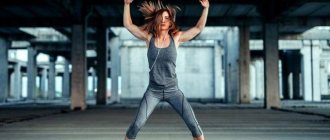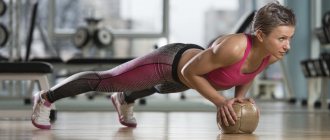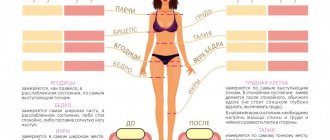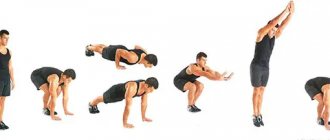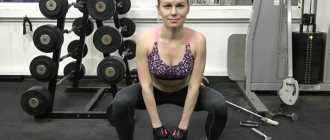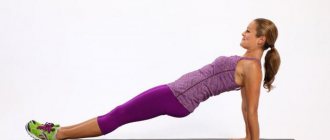Types of measurements
Those losing weight need to take various measurements to obtain accurate data. A larger number of measurements will allow you to notice even small progress.
Weighing
Weight is not the only indicator. In the initial stages, however, it helps well to understand whether the training and nutrition program is effective. In addition, the indicator allows you to understand whether you need to reduce calories or increase them. Body quality, however, can change while maintaining the same mass: there is less fat, and more heavier muscles. A person may look slimmer at higher weights if muscles account for more of the mass. To find out why the weight has decreased, you can use a caliper.
Measurements should be taken at regular intervals without shoes or clothing. It is important to weigh yourself at the same time, on an empty stomach. You should go to the toilet before taking measurements. You can use bathroom scales. You need to stand in the middle of the device, slightly spreading your feet to the sides. If you stand on the edge, the indicators may be distorted.
Weighing yourself will help you track your weight loss progress.
Body measurements
This method is more accurate. You can notice how the body becomes more slender. It is recommended to combine it with weighings.
There are 2 ways to take measurements.
- The first one uses a special measuring tape. The readings can be viewed during the process.
- The second method is not so convenient. Thread is used. Having completed the measurement, you need to record the data obtained, and then take readings using a ruler. An error may occur.
It is important to note in what state the measurement was taken: tense or relaxed. After training, you should not measure: the blood flow to the muscles increases, which is why they become larger in girth. It is best to measure on an empty stomach in the morning. You should not repeat it more than once a week when increasing muscle mass: muscles will not grow during this time. Those who are losing weight can be measured more often, since volumes can decrease faster.
Measuring subcutaneous fat
It is most convenient to make such measurements using special scales that calculate the ratio of fat and muscle tissue in the human body. Accurate results will also be obtained when using caliperometry. The point of this technique is to use a special device, a caliper, to measure the size of the skin fold. The device also gives readings about the percentage of subcutaneous fat. Easy to use on your own at home.
There are other methods, but they are more complicated and a large error is possible.
Photo recording
The technique involves using photographs to determine progress. You need to take photos at the same time (preferably in the morning, before eating). It is advisable to take photos in underwear or identical sportswear that fits your figure: this way progress will be better visible. It is better to take photographs from several angles: front, side, back. It is important, however, that a distance be maintained between the person losing weight and the camera each time. In addition, differences are possible with relaxed and tense muscles.
Using photography, you can track the gradual dynamics of weight loss
Ideal volumes for men
So, let's start with anthropometric measurements by determining the ideal coefficients of your body. They must satisfy the relationships shown in the table below. To determine your coefficient, divide your weight in kilograms by your height in centimeters. If your weight is, say, 80 kg, and your height is, for example, 185 cm and you want to know your ideal chest, waist and hip size, divide 80/185 = 0.432. Thus, checking the table, we see that the coefficient is between 0.423 and 0.451. This means that to determine breast volume, let’s calculate the arithmetic mean between 101.7 and 105.2. We get 101.7 + 105.2 = 206.9 / 2 = 103.4 cm. This will be your ideal chest volume. You understand how to carry out calculations, and now we will present a table with which you will compare the data obtained.
You can measure other parts of the body in the same way. The numbers that you can get from this table are only a certain reference value. If you have never had to lift weights before and have not subjected your body to stress, you can consider these numbers as a starting point in building a muscular body. Write them down and remember them as where you started. In the future, when taking body measurements, it will be interesting to look at your starting point and evaluate how far you have come and what work you have done.
Measuring subcutaneous fat
There are 3 measuring methods.
By fat fold
This is one of the easiest and most accurate methods. For this, someone losing weight will need a ruler. You can also purchase special equipment in the form of a caliper. Specialized stores also have a device for measuring subcutaneous fat. It's called a caliper.
Currently reading
Qigong exercises: 8 exercises for every day for beginners
Hourglass waist, figure in women. Photo, how to make
The essence of the method is that in 4 different places of the human body you need to grab a fold of skin and measure its thickness. The skin most often used is on the waist in the navel area, on the shoulder blade, biceps and triceps. You can also take measurements using a regular ruler. The values are written to the table. Such measurements need to be taken once every 2 weeks.
Scales
To measure subcutaneous fat, you can purchase special scales with a body composition analyzer.
There are varying opinions about their accuracy, but they are very easy to use. You just need to carefully study the instructions for the product.
Internet
On the Internet you can find all kinds of calculators that offer various ways to calculate the percentage of body fat. To do this, just enter the query “calculate body fat” in the search bar and use one of the proposed methods.
Photo recording
Photographic recording is necessary in order to see visual changes. It is necessary to record the general view of the body from the front, back, right and left sides. You can also capture individual problem areas of the body in order to visually observe their changes.
Ideal volumes for women
Below are tables reflecting the ideal (reference) indicators of height, weight, age, waist, hips and more. I emphasize that the information below concerns ideal proportions for women. Men can safely skip this block.
There are various formulas for determining your ideal weight. For some time, in practice, the ratio of weight and height was used according to Brock’s formula: “Ideal weight equals height minus 100.” However, it is now believed that this formula is designed for women 40-50 years old. The optimal weight for women 20-30 years old should be reduced by 10-12%, and after 50 years old it should be increased by 5-7%. Today, tables and formulas are increasingly being used that also adjust for body composition. Using the following table, you can quickly and accurately determine your ideal weight, taking into account your height, age and physique.
Here we also provide a table of ideal hip volumes, taking into account height, age and body type.
For girls, it is worth noting that these indicators are ideal and your body may not currently correspond to them. This is not a reason to be upset at all! On the contrary, these discrepancies can serve as a reason to sign up for a gym and start adjusting your figure in accordance with your preferences, and the tables given here will only help with this and tell you in which direction to move.

